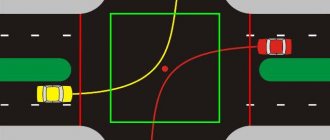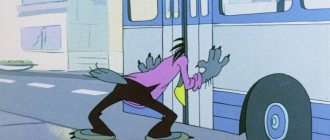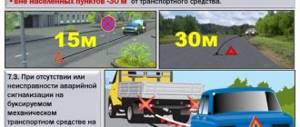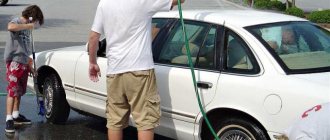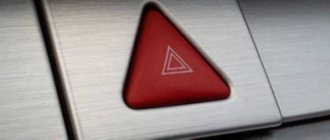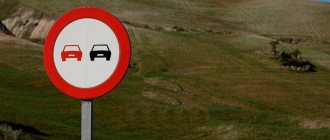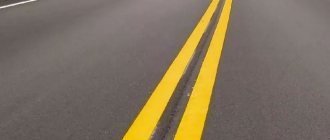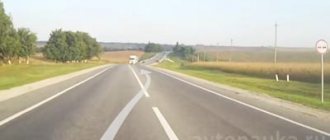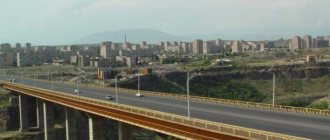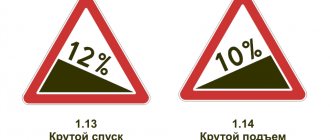Any new participant in road traffic, gaining experience in performing all possible maneuvers on the road, sooner or later has to face the most difficult of them. Until the very end, many people prefer to build their travel route in such a way as to avoid making U-turns in their practice. But it is still necessary to learn how to perform this action. In this article, we will help you figure out where you can turn around according to traffic rules, and where you shouldn’t do it.
A reversal action is used when, due to a number of different circumstances, it seemed necessary to return to an already traveled route. You can’t just suddenly change the direction of travel wherever you want at will. For such techniques, special places are provided, the functions of which are always indicated by paved markings and signs. But first, let's look at the options when you won't be able to make the planned combinations.
Conditions for prohibiting a turn: provisions of clause 8.11 of the traffic rules
Moving along a route, a person, first of all, is guided by a special network of road signs that indicate that the maneuver is prohibited. But the provisions enshrined in law also initially stated several sections of highways where under no circumstances should U-turns be allowed in order to avoid an emergency.
Stops
Public transport stop areas are considered unacceptable for U-turns due to large crowds of people. The trajectory of a car can be sharply shifted at any moment - this endangers people waiting for a bus or tram. The rules stipulate where you can make a U-turn.
It is permissible throughout the entire distance beyond 15 m from stop signs or special yellow markings.
Railroad crossings
The danger of turning combinations at railway crossings is due to the narrowness of the roadway characteristic of these objects. To perform this technique, you need to reverse, and you must concentrate on timing due to the movement of the trains. Where is a U-turn prohibited? In the area between barriers or special car signs.
Pedestrian crossings
In the process of making a U-turn at a zebra crossing, a real danger is created for the lives of pedestrians who have the right of way when crossing the street. If the markings are not visible on the road, try to follow the signs on opposite sides.
A turn according to established standards can be performed before or after a zebra crossing.
Bridges, overpasses, overpasses
These structures do not have enough space to attempt a U-turn from the side of the road, and do not accommodate even small vehicles to make a 180-degree turn. If you do not calculate the trajectory to the minimum values, you can simply crash into the side restrictions of buildings or fall from a height.
Tunnels
The same limited space, coupled with insufficient lighting, does not provide the full possibility of making a U-turn outside the intersection.
Places with low visibility
It is impossible to react in time to the movement of oncoming vehicles, having insufficient visibility within a radius of 100 meters.
If there are signs
To make it clear to the driver where he should not attempt to make a U-turn, the regulations include a special “No U-turn” sign numbered 3.19. The sign shows a curved black arrow within a red circle with a line through it. It is usually located in front of the object where it is forbidden to cross the roadway, so as not to create a danger for cars and pedestrians. But in other directions, the reversal combination can be performed freely. The effect of 3.19 does not apply to vehicles that are subject to following the route.
If it is yellow, then it was installed only temporarily.
Sometimes 3.19 is placed together with the 8.1.1 indicator. This means that the prohibition on a U-turn applies only to the distance specified in the sign. And the indication of the turns “Right turn is prohibited” and “Left turn is prohibited” indicates that it is not advisable to make a U-turn along the indicated path if there are other prohibiting circumstances.
Also prescribing a ban on a reversal combination to the left side include signs with numbers:
- 4.1.4;
- 4.1.1;
- 4.1.2;
- 5.5;
- 5.15.1;
- 5.15.2.
If there are markings
It’s even easier to navigate using the paved markings than using car signs. There are several options when you do not have the right to maneuver:
- if a single solid line is drawn;
- if a double continuous one is applied;
- if one of two lines is broken, you cannot turn to a solid one;
- If the markings indicate the direction of flow along the lanes, then you cannot turn left from the far left side.
On the motorway
The traffic rules also stipulate that it is inadmissible for cars to make a U-turn on the highway or on the road. To perform the required maneuvering, you can use the areas marked with the instructions “Place for a turn” and “Area for a turn.” But using technological gaps for this is strictly prohibited.
No U-turn sign
Turning a vehicle, that is, changing its direction of movement by 180 degrees, is a very difficult and far from safe maneuver. A “No U-Turn” sign is installed in front of an intersection where this maneuver creates a particular danger for the movement of other vehicles and pedestrians.
Where U-turn is prohibited
A U-turn can be performed in any place where it is not prohibited by rules, road signs or markings. Understanding the principles of operation of the “No U-Turn” sign should not be difficult. A “No U-Turn” sign is installed in front of an intersection where this maneuver creates a particular danger for the movement of other vehicles and pedestrians.
A U-turn can be performed in any place where it is not prohibited by road signs or markings.
It is necessary to remember that the sign only prohibits turning, but allows movement in all other directions (including turning left).
Sign 3.19 “No U-turn” can be installed not only on the right, but also on the left side of the road, above the leftmost lane and even on the dividing strip. This is done to increase the awareness of the driver, who is busy preparing the maneuver and concentrating his attention not on the right side of the road.
The rules allow the installation of a “No U-Turn” sign in combination with plate 8.1.1. This combination of signs will mean that the requirement to prohibit a U-turn will apply only through the distance indicated on the sign.
The “No U-Turn” sign (akin to the “No Right Turn” and “No Left Turn” signs) is not valid for route vehicles. Such connivance is due to the need for the minibus driver to move along the route established for him in order to transport passengers.
How to make a U-turn on a busy road
The rule makers are quite clear about whether you are allowed to make a U-turn in different situations. But for beginners, putting all the information into practice at once is not so easy. Therefore, they choose sections where there is the least movement of the moving stream and there is a good view. But what if this process, on the contrary, is very busy in both directions or the area of the roadway is very limited by cars parked on both sides?
We may remind you that in order to pass the exams at the inspection, you needed to resolve the issue of this situation in ways that were not the most familiar. We describe those that car owners can always use without fear of violating the obligations established by the state.
U-turn using adjacent territory
Along the highway there are always various objects that have direct access to it, for example, gas stations, courtyards or parking areas. The traffic police advise how to properly use such areas for entry, so that you can then adjust the required direction in reverse and enter the road again.
An alternative option is to simply drive into a yard or parking lot and make a U-turn on the road inside these fairly common areas in cities. Even a very small area of the area will not interfere with this. It is easier to leave adjacent areas to the right than to the left.
U-turn without intersection
You might have the impression that we will only talk about U-turns at intersections. But that's not true. After all, turning around outside an intersection is also performed by drivers very often and it is an important part of everyday road traffic.
If the markings allow you to make a U-turn on the road, that is, it changes from solid to intermittent on one or both sides, then, taking the extreme left position, begin the maneuver, accordingly allowing oncoming traffic to pass. There is a nuance here: you can make a U-turn on a multi-lane road using this pattern without any particular difficulties; the space allows you to build a trajectory without the need to rest against the curb and back up, which would be inconvenient and very dangerous on a busy road. A turn on a narrow road, as the rules say, can, if necessary, be made not only from the left lane. In this case, take the lane to the right, let the passing traffic pass along with the oncoming one, and then start driving. If there is no right lane (for example, this happens on a narrow country road), then using the shoulder is allowed. It is the curb, not the sidewalk, that is very important. But be careful and attentive, be sure to signal drivers about your intention with your turn signals, because you need to let two traffic pass at once.
If there are tram tracks at the place where you turn outside the intersection, then (in the absence of prohibitory signs and markings, of course) you should make a turn on the road from them. In this case, you miss two streams and a tram.
The main thing about this maneuver is that it should be performed only when you do not create obstacles for other road users. Turning on a four-lane road will not create any difficulties for you: it is wide enough, and you can easily occupy the lane needed for this. Turning around on a two-lane road will be somewhat more difficult, but also quite doable. But we’ll tell you right now when you can’t turn around at all.
Turning around at an unregulated intersection according to the rules
There are many different situations in life when you need to make a U-turn outside an intersection on the road as quickly as possible. Or the right moment to change direction was missed and then you have to turn at unregulated intersections.
This type of turn is considered more risky than at a facility with means of traffic control (traffic light or traffic controller). This is due to several factors:
- the driver needs to constantly concentrate on the surrounding environment;
- traffic exists both ways;
- You need to consider your turning point and the type of road intersection.
Rules for turning at an uncontrolled intersection: traffic rules
Due to the lack of a third-party means of regulating traffic, special attention must be paid to the signs in front of it, both at close range and at a distance. It is car signs that can notify you about where a U-turn is allowed on this site or where it is prohibited.
You cannot maneuver if:
- there are prohibitory signs;
- the markup does not allow this;
- You can only move in the direction specified by the signs.
You should also take into account the fact that you should not drive in reverse at a road intersection. It is necessary, already at the entrance to it, to calculate the trajectory along which the path of movement will be changed, taking into account the characteristics of your vehicle.
Fine for violating U-turn rules
If you turned around, breaking the rules, and this was noticed by a traffic police officer or recorded on camera, then be prepared to pay a fine.
The main violations are as follows:
- Some drivers are in such a hurry that they forget to inform other road users about their actions and do not turn on their turn signals. If you suffer from forgetfulness, then you may face a fine of 500 rubles;
If you turned around in violation of the rules and it was noticed by a traffic police officer or recorded on camera, then be prepared to pay a fine
- if you turned around, ignoring the markings or road signs prohibiting this maneuver, then the penalty will be from 1000 to 1500 rubles;
- driving in reverse in places where it is unacceptable (for example, at an intersection) is subject to a fine of 500 rubles;
- if you turned around from the right lane, then if this fact is discovered you will part with 500 rubles.
Thus, traffic rules quite clearly and clearly inform drivers how and where to turn around. Penalties for failure to comply with the requirements regarding a U-turn are quite democratic, but do not think that it is easier to pay a fine than to drive an extra kilometer and turn around where the signs allow it. By ignoring the rules, you can become the culprit or participant in an accident.
Equivalent roads
It is difficult for the driver to control the situation if there are no priority signs at the intersection. This means that the road surface here has the same structure or that there are no visible landmarks to the main road or to whom to give way. Therefore, already when approaching this place, you need to evaluate all aspects of the real situation, and who should give way while turning around at the same time.
There are two completely equivalent ways to make a U-turn at an intersection with equivalent paths:
- You do not reach its center and make a maneuver.
- Turns in the opposite direction beyond the center point, but without touching the solid line.
Typically, in the situation under consideration, the right interference rule applies. The driver gives priority to the moving traffic on his right side and lets it pass.
Where it is prohibited to turn a car and signs prohibiting a turn
U-turns at a pedestrian crossing or zebra crossing are prohibited. Moreover, it is worth considering that before and after the transition, the maneuver is possible. How to find out the boundaries of a pedestrian crossing if there is no zebra crossing or it is invisible, for example, in winter? Focus on the signs, usually there are two of them (on opposite sides of the road) - the distance between the signs determines the location of the zebra.
It is logical that the confined space and low light do not allow drivers to turn around in tunnels. On bridges, overpasses and the space under them, overpasses - the ban is due to the fact that such structures usually limit the visibility zone - drivers simply cannot correctly assess the situation.
U-turns are prohibited at public and route transport stops as they are always characterized by large crowds of people
At public and route transport stops, as they are always characterized by large crowds of people, which will not allow motorists to turn around there safely. Remember that you cannot turn around within 15 meters on either side of a stop sign or marking (yellow zigzag line).
At railway crossings – potentially dangerous sections of the road that require increased concentration. The ban begins from the place where barriers or corresponding road signs are installed. If the road is poorly visible in at least one direction, then visibility is less than 100 meters.
Prohibiting U-turn signs:
- signs indicate that pedestrians are crossing the road at a given place (5 19 1; 5 19 2; 1 14 1; 1 14 2);
- sign indicating the entrance to the tunnel (1 31);
- signs indicating the boundaries of railway crossings (1 3 1; 1 3 2);
- signs warning of poor road visibility (1 11 1; 1 11 2; 1 12 1; 1 12 2);
- signs informing about the presence of a public transport stop (5 16; 5 17; 1 17);
- signs prohibiting a turn, indicating the direction of movement (1 19; 4 1 1; 4 1 2; 4 1 4);
- double or single solid line signs (1 2 1; 1 3).
U-turn at an unregulated intersection of unequal roads
Priority signs clearly delineate the unevenness of roads. The driver is guided in terms of the sequence of actions and the “Stop” indicator or the presence of a stop line. This means that he needs to stop and think about what to do next. Regulatory regulations require that you give priority for turns at intersections and passage to those who move on the main roadway, while you are on the secondary one.
U-turn rules (traffic rules chapter
You can turn around both at intersections and on sections of the road between them. If there is no dividing strip on the road, a turn outside the intersection should be made where there are no continuous marking lines. In order to turn around on a multi-lane road, you must first find a special place.
It is marked with signs 6.3.1. or 6.3.2., or a break in the marking line 1.3. Within the intersection, a U-turn is made, guided by the requirements of Chapter 13 of the Traffic Rules. It describes the order of traffic at an intersection. Clause 8.5. and the explanations to the road sign “Lane Directions” indicate that you need to turn around at any intersections only from the far left position on your side of the road.
You can also make a U-turn outside the intersection from the right edge of the roadway on multi-lane roads
To clause 8.8. The rules should be consulted if a U-turn is made outside the intersection. It also contains instructions to make a U-turn from the extreme left lane, and on a road with tram tracks laid in the middle of the roadway - from the rails in the same direction.
At the same time, according to the general standards of maneuvering, the driver must, before turning, allow all oncoming trackless vehicles whose path will intersect, as well as trams traveling from behind or towards them, to pass. Outside the intersection, they also make a left turn into adjacent areas, for example, into courtyards.
Sometimes the width of the roadway is not enough to complete a turn from the far left position in one go. Accordingly, a vehicle performing a maneuver unwittingly creates obstacles for the movement of those to whom it should give way. In such a situation, clause 8.8. allows you to start turning not in the extreme left position, but in the extreme right position - from the right edge of the roadway or from the right shoulder. At the same time, all oncoming and passing vehicles driving behind must give way. The driver should wait for the right moment, and then quickly turn around in one go and drive away. This way it will not interfere with other vehicles.
You can also make a U-turn outside an intersection from the right edge of the roadway on multi-lane roads. This method is especially relevant for drivers of long vehicles, the overall dimensions of which do not allow them to turn around from the leftmost lane.
However, there are no rules allowing U-turns from the middle lanes of the roadway. Thus, before turning at an intersection, the vehicle must take the extreme left position; outside the intersection, it must take one of the two extreme positions on its side of the road.
If there is a roundabout, you can only turn around by driving around the center of the intersection. According to clause 8.6. Traffic regulations: U-turns at intersections where the road(s) have a dividing strip should be performed without entering the oncoming lane.
U-turn at a traffic circle
When approaching such an intersection, you can see a blue sign with arrows in a circle. Next to it there are also “Stop” or “Give way”, ordering the passage of everyone who is in the roundabout.
Remember the rules for turning and moving around a circular object:
- You cannot turn around on it when entering.
- You can enter the “ring” if there are no obstacles.
- Before leaving, you need to make a full turn around the “ring”.
- Drive onto the same path you came from, but in the opposite direction.
- You can enter the “ring” in any lane, but exit only in the right lane.
Performing a maneuver at a regular controlled intersection
The following sequence should be followed:
- You need to move to the leftmost lane.
- Drive to the center of the roadway convergence at the traffic light signal.
- Continue to carry out the combination to change your direction after oncoming cars have passed.
Traffic rules at the intersection of roads with a dividing strip
You should begin to change the trajectory of your movement at an intersection, where one roadway has a dividing strip and the other does not, in accordance with the data that you observe in front of you, and constantly reminding yourself of the information that a U-turn is:
- if the dividing line goes to the convergence boundary of the roadway, then the answer to the question “which trajectory are you allowed to make a U-turn on” is unambiguous - only along the far one;
- if it doesn’t reach, then don’t go to the intersection.
